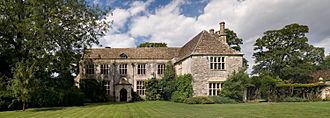Avebury Manor and Garden facts for kids
Quick facts for kids Avebury Manor & Garden |
|
|---|---|

Avebury Manor from the south
|
|
| General information | |
| Type | Manor house |
| Classification | Grade I |
| Location | Avebury |
| Country | United Kingdom |
| Coordinates | 51°25′44″N 1°51′33″W / 51.4289°N 1.8591°W |
| Opened | Early 16th century |
| Owner | National Trust |
Avebury Manor & Garden is a beautiful old house and garden in England. It's looked after by the National Trust, a charity that protects historic places. The house was built a long time ago, in the early 1500s. It's located right in the middle of Avebury village, next to a church and very close to the famous Avebury stone circles, which are ancient monuments.
Contents
History of Avebury Manor
Early Beginnings and Owners
The manor house was built on or near the site of an old religious building called Avebury Priory. This priory was founded in 1114. Later, in 1411, the land became owned by Fotheringhay College. Some parts of the old priory were used to build the house we see today.
In 1548, a man named William Sharington bought the manor. He planned some changes to the building. The oldest parts of the current house were likely built after William Dunch bought the estate in 1551. He was interested in ancient sites like the Avebury stone circles. Around that time, a stone building for doves, called a dovecote, was built in the gardens.
In the 1580s, William Dunch gave the manor to his younger son, Walter. Walter's daughter, Deborah, Lady Moody, grew up at the manor. She later moved to America and helped start a place called Gravesend in Brooklyn in 1645.
Changes Over the Centuries
After Walter Dunch passed away in 1594, his wife, Deborah, married Sir James Marvyn. They added a big new part to the house around 1601, especially the south side. In 1640, the Dunch family sold the house to John Stawell. During a time of war in 1646, his property was taken away because he was accused of treason.
The house was sold to George Long in 1652. But when John Stawell was released from the Tower of London in 1660, the house was given back to him.
Avebury Manor in the 20th Century
Over hundreds of years, the house had many additions and changes. In the 1700s, a court for playing racquets was added. In the early 1900s, the family of Leopold C. D. Jenner lived there and completely redesigned the gardens.
Later, in the late 1930s, an archaeologist named Alexander Keiller leased and restored the house. He was very interested in the Avebury stone circles.
In 1955, many old country houses were being destroyed. Avebury Manor was almost sold off. But then, Sir Francis Knowles bought it from Keiller. He was a brilliant scientist who loved old buildings. He worked hard to restore the house, learning a lot about how it was built. He even found signs of old Gothic arches that had been covered up. The Ministry of Works also helped a lot with money.
In May 1956, Avebury Manor was one of the first smaller houses to open to the public. In 1958, it was given a special Grade I listing, meaning it's a very important historic building. Francis Knowles and his wife, Ruth, raised their family at the manor. Their children remember it as a magical place with lots of space to explore. They even helped with the early tours and serving tea to visitors!
Francis Knowles passed away suddenly in 1974. He is buried in the churchyard next to the house he worked so hard to save.
In 1976, Francis Knowles' wife sold the house to Michael Brudenell-Bruce, 8th Marquess of Ailesbury. After they left in 1981, a property developer named Ken King bought it in 1988. He made some changes without permission and opened a visitor attraction called an "Elizabethan experience," which included a pretend torture room. After he faced financial difficulties, the National Trust bought the house in 1991.
Visiting Avebury Manor
The National Trust keeps Avebury Manor open for everyone to visit. The garden was completely redesigned in the early 1900s. It has carefully shaped bushes (called topiary) and other formal garden areas. These are surrounded by walls and trimmed hedges, creating many different "rooms" in the garden.
In 2011, Avebury Manor was featured in a BBC One TV show called The Manor Reborn. In this show, experts worked with the National Trust to refurbish the house. The series helped bring the house back to life.
Since 2016, visitors have been encouraged to touch and experience the furniture and objects in the rooms. The rooms are set up to show what the house looked like during different periods, from the 1500s to the early 1900s.
Avebury Manor was damaged by flooding on January 5, 2024. The manor is currently closed to the public while repairs are being done. The National Trust hopes to reopen the manor to visitors in time for Christmas 2025.
People say the house is haunted!

